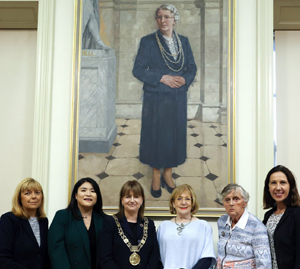BITE-SIZED HISTORY
Published in Issue 6 (November/December 2022), Volume 30BY DONAL FALLON
FOLK 21
Congratulations to the National Museum of Ireland, Country Life (the only branch of the NMI outside Dublin), which has marked 2022 with Folk 21, an exhibition inspired by the 21st anniversary of the institution. The museum site was born out of the Irish Folklore Collection of the institution, which they note ‘started in the 1920s as an ethnographical collection to reflect Irish material culture, to aid the understanding of our archaeological artefacts’. Right up to the end of 2022, there is a chance to see some lesser-exhibited items from the collection of the museum, located in the beautiful Turlough Park in Castlebar.
REMEMBERING MARY O’MALLEY IN BELFAST
Belfast’s newest blue plaque, unveiled at the Lyric Theatre, honours Mary O’Malley (1918–2006). A pioneering figure in the history of the Lyric and of Irish theatre more broadly, O’Malley had emerged from the left-wing New Theatre Group in Dublin before establishing the Lyric in 1950s Belfast. Maintaining that the theatre provided ‘an opportunity for free discussion and the furthering of friendships’, she brought work by diverse artists to the stage and also championed the work and legacy of W.B. Yeats, including many works which had not previously been performed on a Belfast stage. O’Malley’s memoir, Never shake hands with the Devil (1990), is an entertaining journey through Irish theatre in the second half of the twentieth century.
KILMAINHAM MILL
In August, Dublin City Council announced that the first stage of restoration work has commenced at Kilmainham Mill. An important piece of architectural and industrial history in the Dublin 8 area, it began life as a flour mill c. 1800 before later moving to clothing. Kilmainham Mill was captured for ever in David Shaw-Smith’s pioneering television programme Hands and has intriguing connections to fashion and design history. Writing last year in the Irish Times, Deirdre McQuillan noted that in the 1980s its ‘many clients included Karl Lagerfeld in Paris, Harrods and Joseph in London, Barneys and Nieman Marcus in New York and in Ireland fashion designers John Rocha, Lainey Keogh and Paul Costelloe’. A battle with invasive Japanese knotweed, the nightmare of any heritage site, is thankfully in the past.
‘IN DUBLIN THEY REALLY TELL YOU THINGS’
In the capital there is currently much (richly deserved) adoration for poet Pat Ingoldsby, once a familiar face on College Green and Westmoreland Street. Many will recall Pat selling his books of poetry alongside signs proclaiming ‘LIVING IRISH WRITER’ and ‘DUBLIN POET—I’D BE A GOD ANYWHERE ELSE’. This year has seen a Totally Dublin front-page feature, a documentary by acclaimed director Seamus Murphy, and now a new edited collection by the Museum of Literature Ireland (MOLI), ‘In Dublin they really tell you things’. Limited to just a thousand copies, the collection includes poems written during the pandemic. A modern-day Zozimus, Ingoldsby’s poetry often touches on the history of the capital.
KILLING LEPRECHAUNS
With a name that certainly grabs attention, Killing Leprechauns is a new six-part podcast which sees comedian Oliver Callan discuss Irish history with British comedians, seeking to gain some understanding of how much (or how little) they know of Ireland’s past. Available on BBC Sounds, the series features Callan discussing events like the 1649 sacking of Drogheda and the Great Hunger with several of his fellow comedians, all of whom admit their ignorance. Speaking of the show, Callan has noted that ‘it’s not terribly scientific to try and find the level of Irish knowledge among the great British public using comedians, but it is kind of indicative’. While the indicative nature of it may be questioned, it is certainly entertaining.
THREE HUNDRED YEARS OF ST ANNE’S CHURCH
A beloved feature of the Cork skyline, Shandon’s St Anne’s Church marked three centuries on 1 October, although the exact anniversary of the church is disputed. Locals know its famed clock, erected by Cork Corporation in 1847, as the ‘four-faced liar’, and the church is also renowned for its eight bells and distinctive weathervane in the form of a large salmon. Corkonian folklore insists that the county colours may owe something to its distinctive red and white appearance. (History instead points towards the colours of the St Finbarr’s Total Abstinence Hall team as the origin of the red and white.) All in all, St Anne’s is a beautiful example of eighteenth-century church architecture, rightly included in the excellent Cork strolls: exploring Cork’s architectural treasures (2018).
KATHLEEN CLARKE PORTRAIT

Above: At the unveiling of Gareth Reid’s portrait of Kathleen Clarke in Dublin City Hall on 29 September 2022—former and serving female lord mayors of Dublin: Emer Costello, Hazel Chu, Caroline Conroy, Mary Freehill, Carmencita Hederman and Alison Gilliland. (Chris Bellew/Fennell Photography)
This year, 2022, marks the 50th anniversary of the passing of Kathleen Clarke. The widow of 1916 signatory Thomas J. Clarke, Kathleen was a formidable revolutionary in her own right. Active in Cumann na mBan, she was elected a member of Sinn Féin’s National Executive during the War of Independence and later opposed the Anglo-Irish Treaty as a TD elected to the Second Dáil. A founding member of the Fianna Fáil party, she would serve not only as the first female lord mayor of the city but also as its first Fianna Fáil lord mayor. Her memoir, brought to the public thanks to the work of her relative Helen Litton, is one of the most significant firsthand accounts of the Irish revolution. To mark her anniversary, a new portrait by Belfast-born artist Gareth Reid has been unveiled in Dublin’s City Hall. Reid is perhaps best known for his portrait of Irish broadcaster Graham Norton, on display in the National Gallery of Ireland.
















